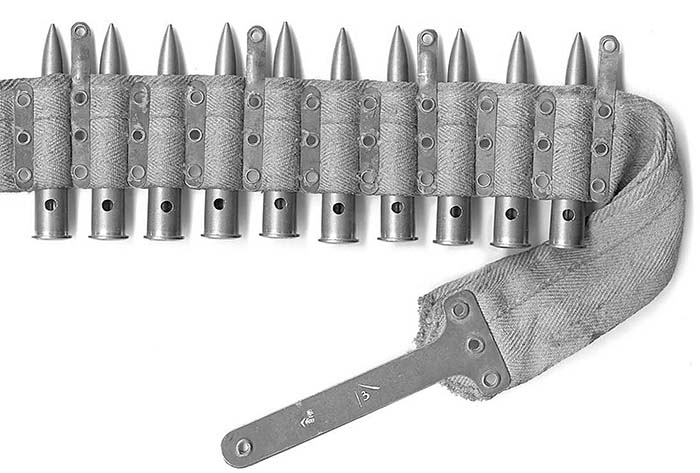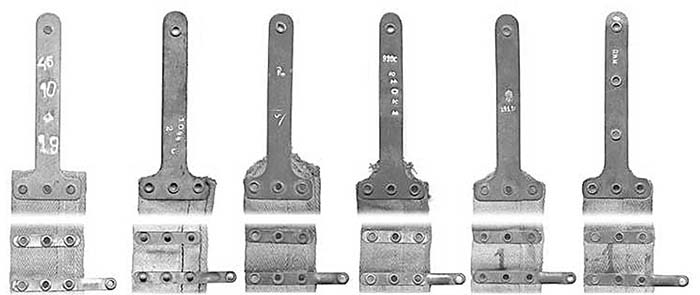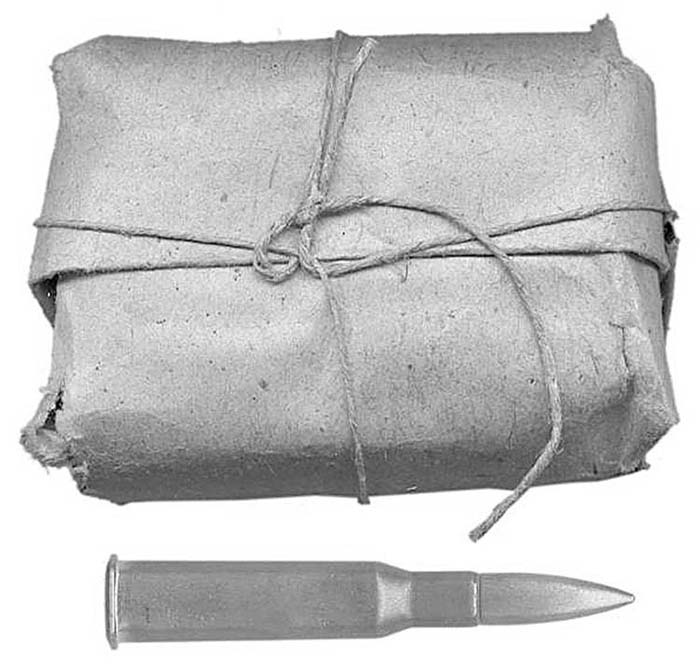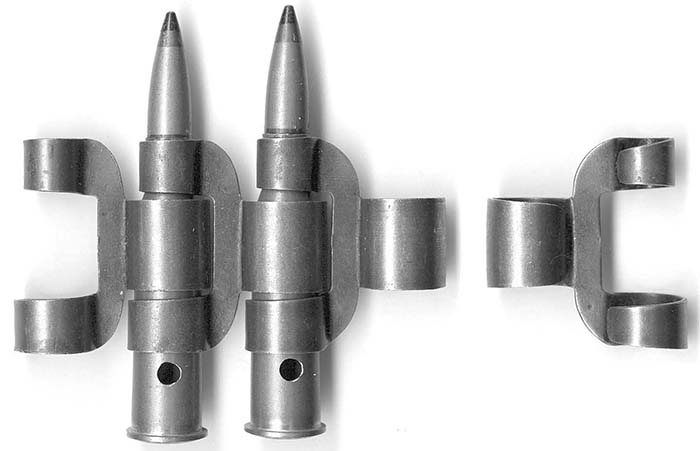By Jean-Francois Legendre
The renowned author Dolf Goldsmith provides in his book “The Devil’s Paintbrush – Sir Hiram Maxim’s Guns” an authoritative study on Russian Maxim machine guns. Other Russian sources also provide some further informative insights on this subject. The present article is intended to focus on the various types of ammunition belts that were used to feed the various Maxim machine guns used in Russian service.
The first Maxim machine guns in caliber 10.6x58R.

As early as 1889, Imperial Russia ordered for trial purpose 12 Maxim machine guns chambered for the black-powder “4.2-line” 10.6x58R Russian Service Berdan cartridge. These early weapons were imported from the British company Maxim Nordenfelt Gun & Ammunition Company Ltd (MNG&ACL). Following these trials, the first Maxim machine guns adopted for operational service were for the Imperial Russian Navy, and were still chambered for the 10.6x58R cartridges.

According to the other contemporary Maxim belts, the fabric belts for the Russian Navy should have had a total capacity of 334 rounds, although the author has so far not examined any complete specimens. The belt is composed of two strips of webbing fixed together by means of riveted brass spacers, thereafter generating the pockets to accommodate the cartridges. A long spacer is installed after every three pockets to insure maintaining a correct seat of the ammunition when the belt is stacked in its transport crate. Both ends of the belt are fitted with starters composed of two flat brass tabs riveted together and are intended to facilitate the introduction of the belt into the feed mechanism.

The very rare specimen observed is a 13-round sample belt kept for reference purposes by the Vickers Company and, hopefully, still survives today. Markings are “RUS V” suspected to mean “Russian Vickers” as well as an inspection mark of the Crayford facility (C/8).

The early Model 1895 machine guns in caliber 7.62x54R.
Immediately following the adoption in 1891 of the “3-line” 7.62x54R Russian cartridge loaded with smokeless powder, the first five Maxim machine guns chambered for that new caliber were tested as early as 1892. In May 1895, the Maxim machine gun chambered for the 7.62x54R cartridge was officially adopted for service as fortress armament bearing the designation of Model 1895. These early machine guns were fitted on a heavy wheeled carriage with large armor shield. In 1896, the Vickers Sons & Maxim Company (VSM) received an order for 174 Model 1895 machine guns chambered for 7.62x54R. This order probably corresponds to the entries in the Vickers Register of Guns for 1897 where 179 guns are referenced with the caliber denoted as “RSB”. Although it has been previously suspected among knowledgeable researchers that this should stand for “Russian Service Berdan” and therefore be in caliber 10.6x58R, Russian sources indicate these were in caliber 7.62x54R. In that case, it is supposed that the “RSB” reference could rather stand for “Russian Service Board.”
According to the size of the early standard wooden ammunition box that can accommodate a 334-round belt with 10.6mm cartridges, the new capacity of the belts for the smaller 7.62x54R rounds was extended to 450 rounds. Unfortunately, the author has never managed, so far, to come across any of these early British-imported 450-round belts of the Russian contract, and accordingly their particularities and markings remain unknown.

In 1897 a first batch of 224 additional machine guns were ordered from the German company Ludwig Loewe, which later became the Deutsches Waffen und Munition Fabrik (DWM). In total, approximately 1,500 weapons were imported from Germany between 1897 and at least 1903. It is supposed that the accompanying ammunition feed belts were probably the standard German capacity of 250 rounds only.

The Russian Model 1905 and 1910 machine guns in caliber 7.62x54R
The first Maxim weapons locally produced in Russia under Vickers (VSM) license are referenced as Model 1905. It is during that year that the first batch of 28 machine guns locally made in Russia came off of the production lines, followed in 1906 by another batch of 73 weapons. In March 1906, a comparative trial was conducted between 3 ammunition belts imported from England and the very first 4 prototype fabric belts assembled in Russia. These first tests showed that the Russian belts were woven too close, which led to misfires. Further investigations finally concluded that the best material suited for the manufacture of the belts was a braid from a Riga textile factory. It is suspected that the early Russian belts had a capacity of 250 rounds only according to that of the belts already imported with the weapons from Germany and also according to the length which became standard among other contemporary Maxim users. In the period 1905-1908, a total of 1,376 machines guns of Model 1905 were produced. While the improved and lightened version of the weapon was adopted under the designation of Model 1910, the accompanying ammunition belts are suspected to have remained unchanged. So far, the earliest belt of local Russian production examined is dated 1910 and the author would be grateful to any reader who might report any earlier date.


The belts of early Russian production are fitted with both starter tags and spacers made of brass. According to the size of the Russian 7.62x54R cartridge, the total length of the long spacers installed every three pockets is 58.5mm. The starter tags are marked with the year of production (expressed with 4 digits) and the Imperial Russian Coat of Arms. The numbering of the cartridge pockets every 10 rounds is printed in tens with usually purple ink (markings ranging from 1 to 25). This cartridge numbering feature is less systematically observed for belts manufactured after the revolution of 1917. The assembly of the two brass plates of the starter tags is made only with a single rivet situated at the end of the tag.



A scarce German DWM belt has been examined bearing most of these Russian unique features and is suspected of having been imported to Russia around 1906-1910 while complying with the official Russian patterns. Both spacers and starter tags are made of brass. The long spacers have a total length of 58.5mm and are assembled by a hollow rivet, which complies with the Russian patterns. This has never been observed on any other DWM production which always relied on solid steel rivets. The assembly of the starter tags fitted at both ends of the belt relies on the German pattern with three hollow rivets; whereas the Russian pattern only involves one rivet. The starter tags are marked with the manufacturer’s initials D.W.M. and are not dated. The cartridge pockets are numbered every 10 rounds, with only the value of the tens (numbers ranging from 1 to 25) being printed with black ink on the fabric. The style of the figures inked does exactly correspond to that found on contemporary DWM belts issued to the German Army. As a matter of summary, for belts with DWM marked starter tags, the total length of the long spacers, the hollow rivet assembling the end of the long spacers and the numbering of the cartridge pockets every 10 rounds are all key features that enable to tell apart these German belts intended for export to Russia. It is suspected that these DWM belts might have been part of an export contract to Russia which also involved the delivery of 7.62x54R Model 1891 round-nosed ammunition from Germany around 1906.

The geometric constitution of these 250-round fabric belts remained unchanged until the latest productions observed up to 1947. Only variants in markings or in the materials used have been examined.


After the revolution of 1917, the first productions of the Soviet era remain fitted with brass spacers and brass starters. The markings are obviously devoid of the Imperial Coat of Arms and only show the year of manufacture expressed with the last 3 digits only. The earliest post Imperial-era belt observed so far is dated 1920 (marking 920).
From the middle of the 1930’s on, the brass starters were replaced by zinc-coated steel ones, which proved mechanically more resilient. The spacers remained, however, usually made of brass. This standard pattern has been observed at least up to 1947 production.

Wartime production belts (1939-1945) are sometimes found with both starters and spacers made of gray phosphated steel. Starters are often undated and bear various small inspection stamps and sometimes a manufacturer’s logo. For example, a belt marked with a “3” in a triangle has been observed, which denotes production at the Tula arsenal. An unusual specimen which seems dated 1944 has been observed with brass spacers and copper plated steel starters, but its origin remains uncertain.
The career of the Model 1910 Maxims continued well after the end of the Second World War. From the end of the 1940’s on, continuous metal belts have been standardized for use with Maxims, SG-43 and RP-46 machine guns. These belts with a capacity of 250 rounds are composed of metallic pockets joined together with coiled steel springs. Each end of the belt is fitted with a long starter tag with curved end to facilitate the gripping. Although similar metallic belts were tested as early as 1940 for use with the DS-39 machine guns, and were also used in some combat with SG-43s since 1944, it seems that large scale production did not begin before the end of WW2. Russian sources indicate that although a modified feed-block for the Maxim Model 1910 was designed during WW2 to cope with both fabric and metal belts, the quantity of fabric belts available in stock was so huge that this modification was finally not made on wartime weapons. World War II dated photographs showing Model 1910 Maxims fed with metallic belts have not been observed so far by the author.
The air cooled Maxim-Tokarev Model 1925 light machine gun.



In the middle of the 1920’s an air cooled light machine gun in caliber 7.62x54R was designed at the Tula arsenal and was adopted as the Maxim-Tokarev machine gun Model 1925. Standard production of the weapon started at Tula in November 1925 and, by 1927, a total of 2,500 weapons had been manufactured. These light machine guns were designed to use the same 250-round fabric belt as those for the heavy water cooled Model 1910 Maxims. However, following the principle used by the German MG 08/15 during the First World War, the Russians also designed a belt drum which accommodates a 100-round belt for these Maxim-Tokarev guns. Only very few photographs depict these belt drums and it remains unclear as to how the drum is fastened to the gun itself. It also seems that these drums are fitted with an internal spool around which the belt is wound up and therefore took example on the design of the German Gurttrommel of MG 08/15. Photographs however state that both drums are externally different. Russian sources indicate that the 100-round belts used with those drums were simply shortened 250-round standard belts. Although very large quantities, if not all, of those Maxim-Tokarev light machine guns were exported to Spain during the Civil War in 1937-1938, it seems that the belt drums were not included in the shipments since no such item has ever been commonly reported from Spain so far.

The air cooled aircraft Maxim PV-1.
An air cooled fast-firing aircraft machine gun was investigated at Tula arsenal since 1923. This weapon was formally adopted by the air force in 1928 as PV-1 and a total of more than 17,800 weapons were produced between 1926 and 1940. This aircraft weapon was primarily designed to be fed with disintegrating metallic links. Although the design of the very first prototype links developed before 1930 is not known, in the later years the disintegrating metallic links used with the Maxim PV-1 were the same as those used with the ShKAS aircraft machine guns. Two major variants are identified: one seldom encountered which is completely smooth, and the most common bearing a set of ribs. Some of these aircraft Maxim PV-1s also found their way into the Spanish Civil War and some photographs show them heavily reworked and reissued for ground use fed either with metal disintegrating links or fabric belts.


Acknowledgements :
Special acknowledgments are due to the late Herb Woodend who spent hours searching through piles of Russian fabric belts to retrieve some of the variants presented in this article. The author is also very grateful to Mr. Kooger and Wanting (the Netherlands) and Bob Faris (USA) for their useful comments.
| This article first appeared in Small Arms Review V9N3 (December 2005) |











